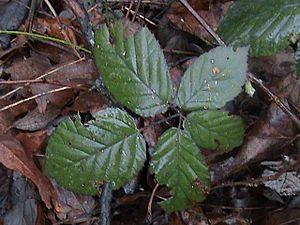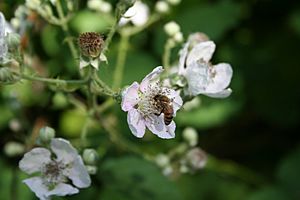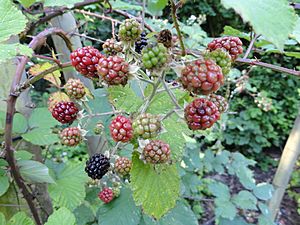Himalayan blackberry facts for kids
Quick facts for kids Rubus armeniacusHimalayan blackberry |
|
|---|---|
 |
|
| Himalayan blackberry 5 leaf example | |
 |
|
| Scientific classification | |
| Genus: |
Rubus
|
| Species: |
armeniacus
|
| Synonyms | |
|
|

The Himalayan blackberry, also known as Rubus armeniacus or the Armenian blackberry, is a type of blackberry. It originally comes from Armenia and Northern Iran. However, it has spread and now grows naturally in many other parts of the world.
For a long time, people were confused about its scientific name and where it came from. Some thought it was from Western Europe. Today, it is known as Rubus armeniacus.
In some places, people grow this plant on purpose for its tasty berries. But in many other areas, it is seen as a noxious weed and an invasive species. This means it grows too much and can harm local plants and ecosystems.
Contents
What Does It Look Like?
The Himalayan blackberry is a perennial plant. This means its roots live for many years. Each year, new stems, called "canes," grow from these roots.
In its first year, a new cane grows very fast. It can trail along the ground or arch up to 4 meters (about 13 feet) high. These canes are thick, sometimes up to 3 centimeters (about 1 inch) wide at the bottom. They are usually green and have a hexagonal (six-sided) shape. They also have very sharp thorns, which can be up to 1.5 centimeters (about half an inch) long. If the canes get a lot of sunlight, they might turn a reddish-purple color.
The leaves on these first-year canes are large, about 7–20 centimeters (3–8 inches) long. They are shaped like a hand with three or five leaflets. These leaflets have slightly jagged edges. First-year canes do not produce any flowers.
In its second year, the cane stops growing longer. Instead, it grows several side shoots. These side shoots have smaller leaves, usually with three leaflets. These leaflets are oval-shaped, dark green on top, and lighter underneath. They also have jagged edges and hooked thorns along the middle vein on the underside.
Flowers and Fruit
The flowers appear in late spring and early summer. They grow in clusters of 3 to 20 flowers at the tips of the second-year side shoots. Each flower is about 2–2.5 centimeters (about 1 inch) wide. They have five white or pale pink petals. These flowers are "bisexual," meaning they have both male and female parts to help them reproduce.
The fruit of the Himalayan blackberry is not a true berry in a botanical sense. Instead, it is an "aggregate fruit." This means it is made up of many small, juicy parts called "drupelets" all joined together. Each fruit is about 1.2–2 centimeters (about half an inch to an inch) wide. They ripen to a black or dark purple color.
Both the first-year and second-year canes have many short, strong, curved, and sharp spines. Older plants can form dense tangles of arching stems. When the tips of these branches touch the ground, they can grow roots, helping the plant spread even more.
Why People Grow It
Berry Crop
The Himalayan blackberry was brought to Europe in 1835 and to Australia and North America in 1885. People liked it because its fruit is similar to common blackberries but often larger and sweeter. This made it a good choice for growing berries at home and for selling. Unripe fruits are smaller, red, and hard with a very sour taste.
Some popular types of Himalayan blackberry that people plant are 'Himalayan Giant' and 'Theodore Reimers'. This plant was also used to create a famous type of blackberry called the Marionberry.
Providing Cover
If left alone for several years, Himalayan blackberry plants can grow into very large, thick patches of canes. These dense thickets can be good places for birds to build nests. They also offer places for small mammals, like rabbits, squirrels, and beavers, to rest or hide.
As an Invasive Species
The Himalayan blackberry quickly escaped from cultivation. This means it spread from gardens and farms into the wild. Now, it is an invasive species in many parts of the world with mild climates. It is very hard to control once it starts growing. Birds and other animals eat the fruit and then spread the seeds, helping it spread even faster.
These plants are also very flammable. They can act as "ladder fuel" for wildfires. This means they help fire climb from the ground into taller trees because of all the dry leaves and dead canes they produce.
It is especially common in the American Pacific Northwest and parts of British Columbia. It grows well near rivers and streams because there are many other plants there, which helps it go unnoticed until it has grown a lot. Unlike some other invasive plants, the Himalayan blackberry can grow and spread easily even in areas that haven't been disturbed.
Trying to get rid of it by just cutting the canes to the ground or burning the thickets usually doesn't work. The best ways to remove it include digging up its underground roots and structures. However, even small pieces of broken roots can grow into new plants, making manual removal a lot of work. Some common weed killers, like glyphosate, are also not very effective against this plant.
Images for kids
See also
 In Spanish: Zarza armeniana para niños
In Spanish: Zarza armeniana para niños




